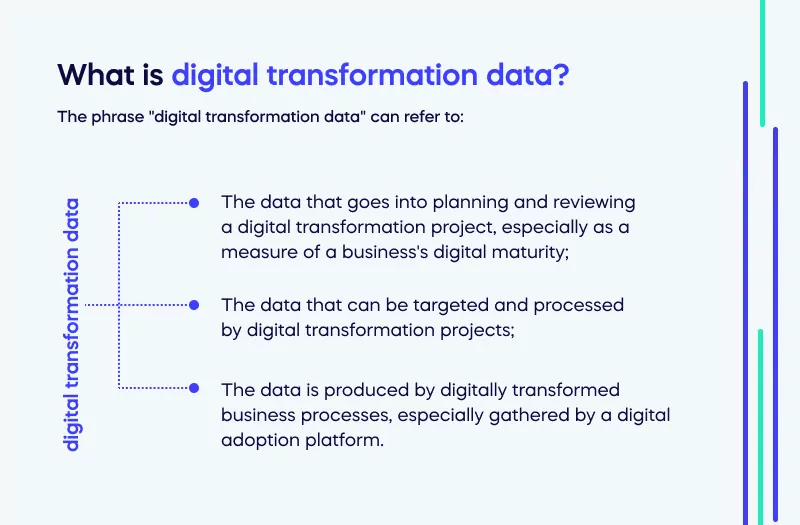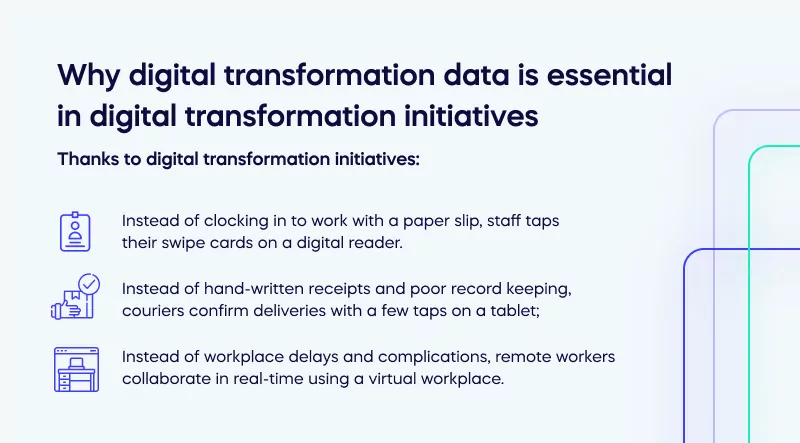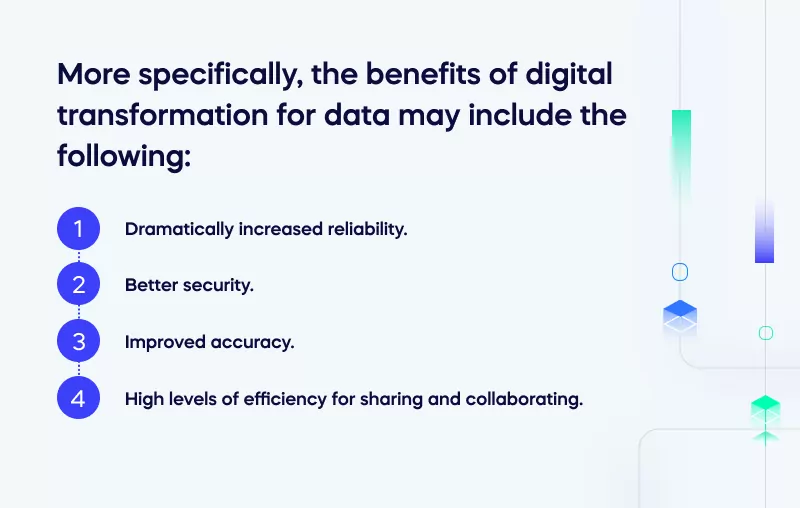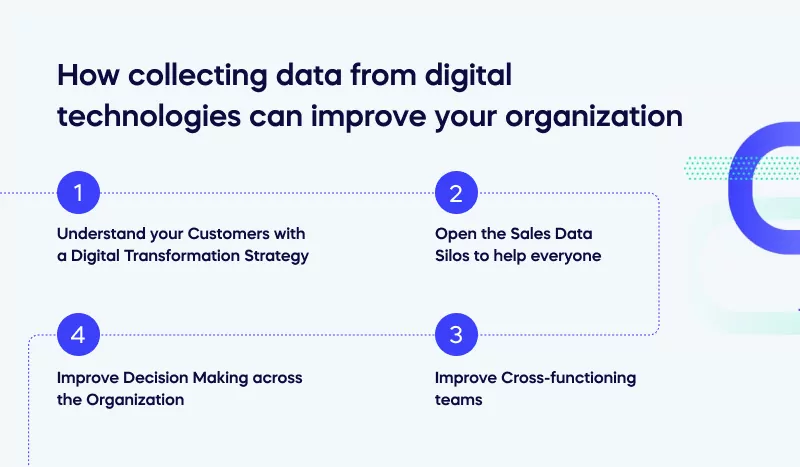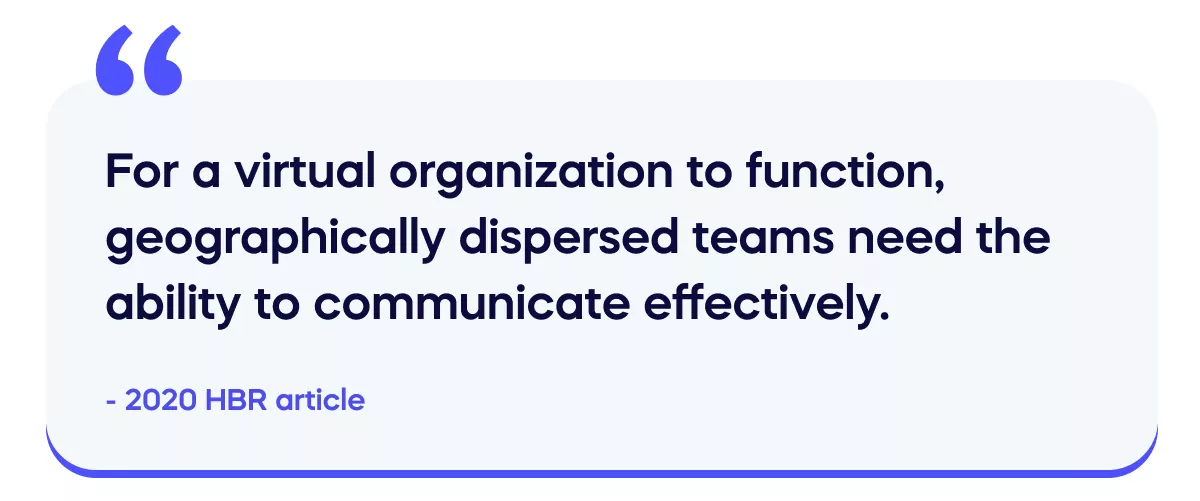Digital transformation data plays a critical role in digital enablement.
Leaders worldwide now recognize that going digital is critical to the future of business. But successful transformations don’t stop after rolling out a few new apps. Following implementation, organizations can leverage the ongoing data collected by digital tools to make better decisions for employees and customers.
Here, we will examine the role of digital transformation data in organizational business initiatives. We’ll explain the different types of data and show how each is essential for various parts of a project, as well as how digital transformation is vital for tracking data within complex organizations.
Finally, we’ll introduce critical ways organizations can improve using data either for increasing operational efficiency, providing a seamless customer experience, or supporting decision-making at every level.
What is digital transformation data?
The phrase “digital transformation data” can refer to:
-
The data that goes into planning and reviewing a digital transformation project, especially as a measure of a business’s digital maturity
-
The data that can be targeted and processed by digital transformation projects
-
The data that is produced by digitally transformed business processes, especially in the context of a digital adoption platform
Before all else, data helps businesses plan their transformations. Every change management project starts with leaders making sense of the problems their company faces. Data on revenue, performance, business outcomes, and existing technology adoption should all inform a business’s digital transformation strategy. Gathering comparable business data in the months following a project also enables a detailed evaluation. In other words, a data-driven mindset is essential.
Second, most digital transformation projects share the aim of gathering, processing, and sharing data more efficiently. Most business operations will run more effectively with reliable, accurate, and transparent data processing, whether it relates to customer experience, employee performance reviews, or informed decision-making at the C-suite level. New tools can break down data silos and support communications and transparency.
Finally, a successful digital transformation strategy often produces new forms of data which can tell you a lot about how employees use digital tools. Organizational change leaders can use usage, device, and support data to reveal an accurate picture of the company’s digital journey. This data can help plan for future work and employee training.
The most important thing is not defining “digital transformation data”, but rather understanding that data.
Why digital transformation data is essential
Data is crucial to any digital project. Digital transformation makes data sharing more reliable, accurate, and secure. Implementing digital tools may have high up-front costs, but they achieve long-term value through benefits that bring a major competitive advantage.
We now live in a profoundly digital age, and it is easy to forget how much data was processed using manual tools in the past.
Thanks to digital transformation initiatives:
-
Instead of clocking in to work with a paper slip, staff tap their swipe cards on a digital reader.
-
Instead of hand-written receipts and poor record keeping, couriers confirm deliveries with a few taps on a tablet.
-
Instead of workplace delays and complications, remote workers collaborate in real-time using a virtual workplace.
Digital transformation takes fragile, disconnected, and unreliable data and turns it into a force to move any business forward.
As these examples show, such transformations bring incredible benefits to a business.
More specifically, the benefits of digital transformation for data may include the following:
-
Increased reliability. Digital data is less likely to be lost or corrupted than physical data. With digital solutions, businesses ensure that their record keeping is always accurate and up-to-date.
-
Better security. Digital solutions can provide better protection for businesses. Even when people across an organization must access data, the privilege to see specific data can be tightly controlled and tracked.
-
Improved accuracy. Automation reduces the risk of human error and leads to more accurate data entry, analysis, and reporting. Mistakes can be easily traced and rectified across a whole system.
-
More efficient sharing and collaboration. Digital solutions make it easier to share data and collaborate on projects. Even for advanced technological projects, cloud computing solutions mean that team members can access the same data from different locations. Digital solutions make it easier to track changes and keep a history of all project versions, thereby reducing the chances of mistakes.
Digital transformations achieve these benefits with considerable cost savings over alternative solutions.
How collecting data from digital technologies can improve your organization
There are many ways that data can improve business performance. In this section, we will explore how data can improve businesses’ understanding of their customers, sharing data, creating cross-functioning teams, and making decisions across the organization.
Understand your customers
Businesses with a fully digitized customer experience can collect valuable data about their buyers. A company can now collect information about purchase histories, contact information, and support data to deliver the most effective solutions to every one of its clients.
However, in the age of big data, businesses can become overwhelmed by the sheer amount collected. A 2020 HBR article advises that companies keep an idea of the “whole person” while collecting data and consider “not just what we will click, but what is compelling on a deeper level.”
A digital transformation can bring in plenty of great information about consumer behavior. But companies can only leverage this information when they have a defined data strategy and responsive business models.
Open the sales data silos to help everyone
Digital transformation can solve long-standing challenges in data sharing. For example, sales data can provide a wealth of insights for everyone in an organization. Sales data can be used to analyze trends, track customer behavior and preferences, identify market opportunities, forecast future performance, and more. In the past, many businesses have tried to analyze this data effectively. But now, digital solutions make it easy for everyone to access this knowledge.
In a 2020 article, Alyssa Merwin explained how Sales data could impact the whole company. With the rich information sales data provides, the marketing department can make better decisions, account managers understand their client needs better, and leaders can identify growth opportunities.
Instead of labor-intensive tasks, digital technologies make it easy for businesses of all sizes to collaborate and share insights from the sales team.
Improve cross-functioning teams
Remote working has changed dramatically since the start of the global pandemic in 2020.
Email and shared drives were game-changing in their times. But now, digital innovation means that location is no longer a barrier to data sharing. In more and more workplaces, digital solutions now allow remote workers to access the same resources on-site employees have. Digital transformation can support remote working by accessing data from any location, rapidly sharing files and documents, and improving communication between staff members.
As a 2020 HBR article explained, “For a virtual organization to function, geographically dispersed teams need the ability to communicate effectively.” Businesses now have a whole range of applications that have transformed remote collaborative work for so many people. Teams, Google, Slack, and more all mean that documents can be rapidly and reliably shared across departments.
Improve decision making across the organization
The data from digital transformation can make a major difference in all aspects of a business. However, digital mature organizations must make data a core part of decision-making. It shouldn’t be an afterthought.
HBR reported that more than 70% of senior leaders had not developed a full digital culture. By changing their perspective, leaders at all levels of an organization can improve their decisions using data.
Instead of relying on vague averages, they can refer to precise segments of customer activity. And when companies have a single package for data management, for example, in an ERP, there is no debate about the core information. In these situations, decision-making can follow from data – not the other way around.
Actionable insights: The future of smart business
Exploring data shows us how digital technology and data and analytics components will be essential for any business strategy in the next decade.
By gaining visibility into their tech stacks, organizations can analyze data to optimize their operations, improve both employee & customer service and communication, and make more strategic decisions.
Digital transformation data ensures that businesses are equipped with the latest insights and information to stay competitive in today’s fast-paced environment. With excellent data sharing, businesses can ensure their remote workers remain just as productive as on-site colleagues and make sure that decisions are made accurately and with the benefit of data-driven insights.
Ultimately, digital transformation data enables businesses to remain competitive and create a more agile, customer-centric environment, and using the right tools means that companies can turn insights into action quickly and effectively.
Accelerate your digital transformation journey
WalkMe’s low-code digital adoption platform enables organizations to leverage data to take immediate action to simplify user experiences across enterprise applications. WalkMe is designed for executives, IT organizations, and line of business managers, enabling them to take a user-first approach to software adoption to accelerate digital transformation.


